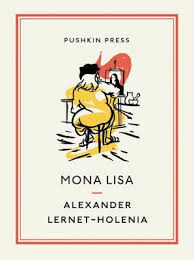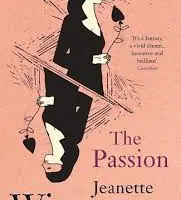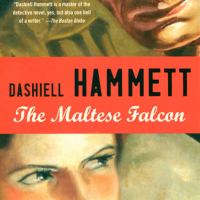Mona Lisa, by Alexander Lernet-Holenia and translated by Ignat Avsey
Charming isn’t a word I get to use often enough on this blog.
I liked but didn’t love Alexander Lernet-Holenia’s I Was Jack Mortimer and it’s fair to say that I like but don’t love Leonardo da Vinci’s Mona Lisa. For me the Louvre contains far more interesting treasures. The painting has become a form of celebrity – a canvas Kardashian. Obviously it’s good, but I’ve never thought it merited its peculiar fame.
Put those views together and I’m not a natural reader for Lernet-Holenia’s novella about, in part, the Mona Lisa. That was very nearly my loss as, and here’s that word again, it’s one of the most charming books I’ve read in years.
Pushkin have done themselves particularly proud with this edition. The book itself is up to their usual exceptional standards but as well as the usual good quality paper and attractive cover they’ve also included some rather charming (there’s that word again) line illustrations by artist Neil Gower throughout the text. There’s a picture of one at Jacqui’s Wine Journal’s review (link at the end).
As the book opens King Louis XII is sending one of his marshals, Louis de la Trémoille, to the relief of his French governors in Naples who are being harried by the Spanish. The king’s orders are a small work of comic brilliance:
“And I trust, sir,” the King went on, “you will be able to acquit yourself of this commission with your customary prowess. You shall not be left wanting anything. I send you forth not only with my own blessing, but also hereby give you leave as you make your way through Rome to seek the Holy Father’s blessing. However, in case the Holy Father should refuse to anoint your arms, I give you full permission to urge His Holiness, with the help of those selfsame arms, to vouchsafe them his blessing. Furthermore, select as many of my noblemen as you deem fit to accompany you on your way. The flower of my nobility will be honoured and pleased to serve under you and personally to provide armour and equipment for you and your retainers. Also, you will have at your service a number of clerics whose upkeep and maintenance will devolve upon the Church. I shall take the sin of that upon myself. Additionally, I expect the good people of Amboise in Milan to cast the requisite number of ordnance, furnish the requisite number of ensigns, standards and trumpet banners, and supply a sufficient quantity of drums, kettledrums and trumpets. The cost of the undertaking is to be met from the municipal funds. You will of course have at your disposal as many horse and foot as you shall need, fed and nourished off the land, so help you God.”
With such assistance how could the expedition be other than a glorious success? M. de la Trémoille and such lesser noblemen as he is able to persuade to join him set off across France and into Italy.
The king also gave M. de la Trémoille orders to seize such treasure along the way as he is able. With his small and ill-equipped force M. de la Trémoille hasn’t been able to gain anything of consequence so when he reaches Florence it seems a good opportunity to pick up some local art. He takes a few companions and calls upon the famed Leonardo da Vinci, who sadly seems rather more frivolous than expected:
“My investigations,” Leonardo said, “led me, after my enquiries into the density and flow of water and air, to other things, and for a few days I was preoccupied with the weight of God.”
Leonardo seems as distractible as a child. His study shows no signs of current work and he seems to have musicians and dancers attending on him whenever the French call. However, a chance argument between Leonardo and M. de la Trémoille changes everything when one of M. de la Trémoille officers, the young Monsieur de Bougainville, is instructed to catch a fly to settle an argument between Leonardo and M. de la Trémoille as to how many legs it has.
Monsieur de Bouganville disturbs a curtain at the back of the room and behinds it catches a glimpse of glory. It is the Mona Lisa, unfinished, as yet imperfect, but already beautiful. M. de Bouganville falls instantly in love.
From there the story moves to M. de Bouganville’s attempts to discover the model for the painting. He’s told it might be based on a woman known as La Gioconda, third wife to local nobleman Francesco del Giocondo. She is said to have died some years previously of the plague but:
It struck young Bougainville as totally improbable that Leonardo would have painted a woman who was no longer alive.
M. de Bougainville convinces himself that La Gioconda must be the real model for Mona Lisa and that she remains alive. Before long he’s causing outrage; he exhumes her tomb and raids del Giocondo’s house believing her imprisoned there. He is mad. He is in love.
With another writer or perhaps even with Lernet-Holenia in a different mood this would all make quite a nice little historical thriller. Here it’s obvious that M. de Bouganville’s quest is hopeless. Leonardo insists that the picture is based on a composite of various women and there’s no reason at all not to believe him. No reason except love, which is its own reason.
Mona Lisa (the book) becomes a short comic meditation on love and art and how both can make us lose ourselves in something better than we would otherwise be. It’s a lovely little tale. Funny, fast moving, and to return to where I started this piece, utterly charming.
Other reviews
There are loads and I’m sure I’ve missed a fair few of them. The ones I had noted were from Jacqui’s Wine Journal here, which includes a nice picture of one of the illustrations; from His Futile Preoccupations here; and from 1st Reading’s blog here. Please feel free to let me know of others in the comments.














I liked “Jack Mortimer” too and I kept meaning to get round to this one after Jacqui’s excellent review. Thanks for reminding me…. 🙂
Isn’t it great? An utterly captivating little book! I’m so glad you loved it too. Your opening quote takes me right back into the story complete with all its charms – what a wonderful tone of voice he employs there.
I don’t know if Lernet-Holenia wrote anything else in a similar style, but if so I would love to read it.
Many thanks for the link to mine – it’s very much appreciated.
I think you’d like this Kaggsy. It worked well as a refresher after the rather gory Manchette.
It is, absolutely Jacqui. I know that was a long quote, but I think the length goes to the comedy as it becomes steadily more apparent that the king actually isn’t helping at all.
I always rather like linking to others. After all, it’s a conversation isn’t it?
I haven’t read your review or any of the others because I have this book on my TBR and have thus bookmarked this for later, but I must share my lucky experience with the Mona Lisa at the Louvre…
I have no doubt that it’s usually a bruising experience to fight your way through the crowds, but on the day we visited we had bought our tickets in advance from back in Australia and so we sailed past the admission queues and made our way inside, no dramas. There was hardly anybody about because the place had only been open for a couple of minutes, and when we got to the ML room there was only a group of about 20 Japanese tourists and when they left, we were the only ones in the room.
I reckon that makes us members of a most exclusive group: people who’ve actually been able to see the painting properly!
I read this on a flight home after a particularly vexing day at work – it cleared the mind and changed the mood. A wonderful little treat.
I think you’ve summed it up perfectly – and there’s certainly a need for funny, fast-moving and utterly charming fiction in my life at times! I hope Pushkin make more of his work available.
Sorry all, I’ve been travelling with work and then on holiday.
Lisa, that is lucky, extraordinarily so. I’m rather jealous – like most I’ve barely managed to see it and that only briefly due to crowds.
Ian, a wonderful little treat, exactly. It is perfect for clearing the mind.
Grant, in all our lives I imagine. Not as common as it could be though. There is I think sometimes a bit of a prejudice against light fiction, but it’s not necessarily all that easy to pull off. Bookertalk reviewed Diary of a Nobody recently which is another charming book which springs to mind. Again, not as easy to pull off as it looks.
The thing about Leonardo’s work is that they often hang his paintings in the midst of other Rennaisance artists, who had obviously all learned from him. If you put his work in its chronological position, it really shows the huge leap he made from the more naive styles that went before.
That’s a very good point Alastair, and I admit may have influenced my views on his work.